A random list of cycling facts – from the invention of the bike to the fastest time circumnavigating the world.
When Was the Bike Invented?
No one really knows exactly. The Frenchman Ernest Michaux invented a bicycle with pedal and rotary cranks in 1861, but it is doubtful this was actually the first design.
Early precursors to the bicycle include:
1817 – The Running Machine. Invented by the German Baron Karl von Drais, this had no pedals, no chains, but two wheels. It was propelled by pushing your feet on ground. It was sometimes known as human horse. It was largely a form of entertainment for aristocratic families with their own estate. It never really caught on, but is important for giving idea of bicycle shaped objects.
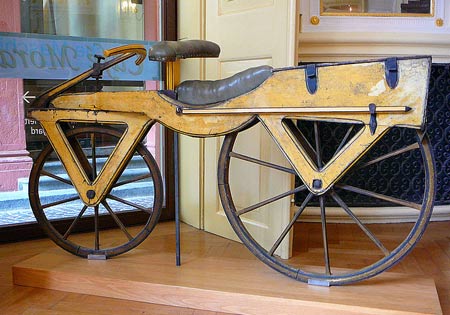
The Running Machine. Photo by Gun Powder Ma wikipedia
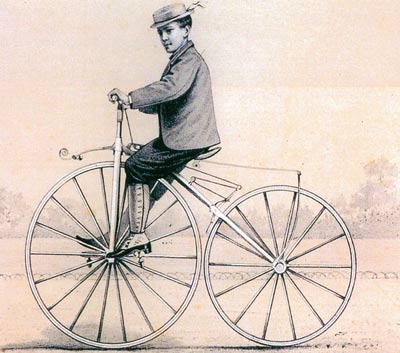
The Velocipede – 1860s. In the early 1860s, two Frenchmen Pierre Michaux and Pierre Lallement put pedals on the front wheel and introduced the velocipede, which looks more like our modern bicycle. It had no chain and was very uncomfortable due to the wooden wheels. The velocipede helped the spread of the bicycle.

The Penny Farthing. A development of the Velocipede, this was faster due to the larger diameter of the front wheel. But, considered dangerous because of its height. Nevertheless Penny Farthings became quite popular and the first cycle races were on these high machines.
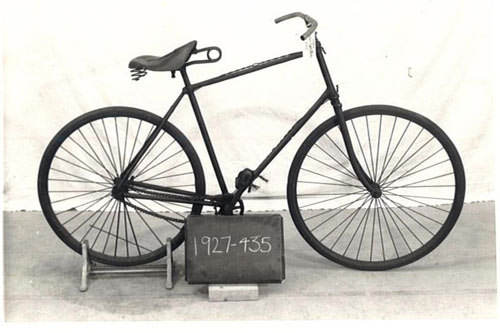
1885. The Safety Bike. It was around the 1880s, that the first safety bikes appeared. These are considered the first real bicycles. With their standard two triangle frames, pedals and chain, the basic design has remained unchanged. Starley’s 1885 Rover is considered the first real bicycle model.
When was the Pneumatic tyre
In 1846 Robert William Thomson patented a pneumatic tyre. But, he was never able to make it a practical reality. In 1888, Scotsman John Dunlop invented the first practical pneumatic tyre, which created a much more enjoyable and comfortable ride. A year later, in 1889, the racing cyclist Willie Hume won 4 races using Dunlop’s tyres in 1889 The bicycle was ready for mass participation and the first puncture repair kit was invented pretty soon after.
Innovations for bicycles which later appeared in motor cars
- Pneumatic Tyres
- Precision ball bearings
- Tension-spoked wheels
- chain-drive,
Motor Engineers who started off producing bicycles
Henry Ford, Wright Brothers. Dunlop tyres, The Rover Cycle Company, Morris Motor Company.
Who were the first group to campaign for better roads?
Cyclists. In the US in the 1890s, it was cyclists who were prominent in the Good roads movement. A magazine Good Roads Magazine was founded in 1892 by cycling advocates. It reached a subscription of 1 million within 3 years. A year later (1893) after Good Roads magazine was founded, Charles Duryea produced the first American gasoline-powered vehicle, and within 20 years cars had replaced bicycles as the most popular users of American roads. But, those early motorists befitted from the campaigning by cycling groups.
Cycling and Social Change
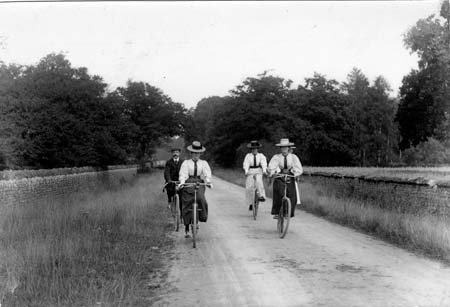
Cycling is credited with playing a role in the increased social mobility and emancipation of women and the working class. In the late nineteenth century, the safety bicycle gave a whole new section of the population their first personal transport. It enabled, people to live further from work, helping to create the modern commuter.
An American women’s rights activist, Susan B. Anthony wrote in the 1890s.
“Let me tell you what I think of bicycling. I think it has done more to emancipate women than anything else in the world. It gives women a feeling of freedom and self-reliance.”
The Worlds First Bike Race
The world’s first bike race was won by James Moore, an Englishmen, in Parc de St Cloud Paris on Friday 31st May, 1868. It is said the race was The race was ‘from the fountains to the barrier and back.’
Oldest Bike Race
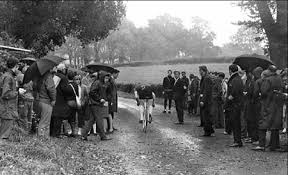
The longest running bike race is the Catford CC hill Climb, first run on Westerham Hill on August 20th 1887. Riders rode a mixture of ‘safety bicycles’ and penny farthings – all on solid tyres. Of 24 starters, only 12 made it to the top. The race is now run on a steeper hill York Hill, with a maximum gradient of 25%.
Oldest Pro Cycle Race
The oldest pro cycle race is Liège–Bastogne–Liège (Belgium) – ‘La Doyenne’, It was first held in 1892, and is called La Doyenne’, (the oldest) For the first two years it was amateur, but from 1894 was open to professionals.
Oldest Three Week tours
The oldest Stage race is the Tour de France, first held in 1903. The Giro d’Italia followed in 1909 and the Vuelta a Espagne in 1935.
How fast do they do the Tour de France
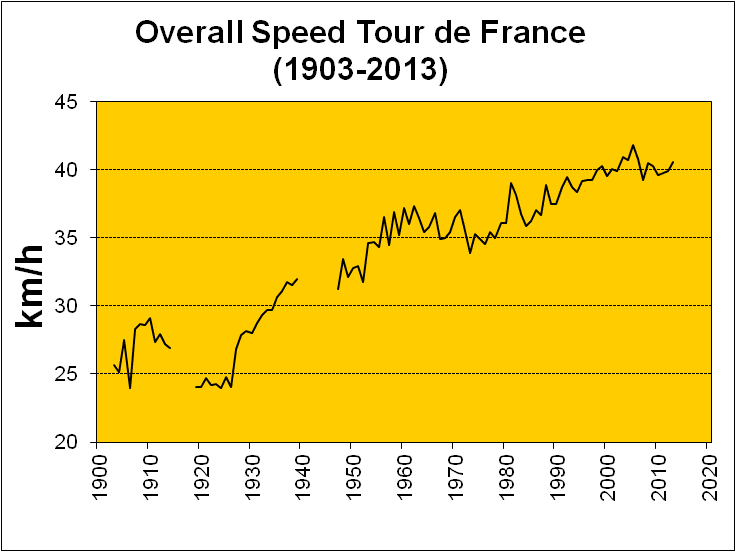
From an average speed of 24 km/h in 1926, the average speed of the Tour de France peaked in 2005 at close to 42 km/h. More facts on the Tour de France
Biggest cycle race
Cape Town Cycle Tour is the largest recorded cycle race. There have been up to 35,000 finishers. (Cape Town Cycle Tour)
Strange Disqualifications
- The first Englishman to ride 25 miles under an hour was Ralph Dougherty. He was also the first UK cyclist to be disciplined by the UK for his choice of socks. He didn’t wear black, which were compulsory at the time. (This Island Race – Les Woodland)
- On a slightly more serious note, in the 1904 Tour de France, 12 riders were disqualified for reasons varying from ‘taking a train’ to using cars. The reasons were never published, but, so many riders were disqualified, the fifth placed rider Henri Cornet, aged 19 was eventually crowned the winner. 1904 Tour
Cycling in Secret
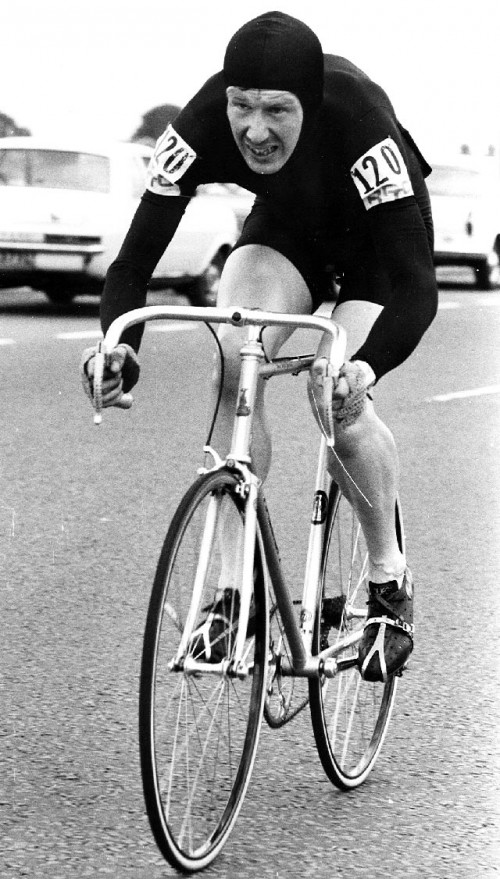
Whilst mass cycle races flourished on the continent, in the UK they were banned – for the reason cyclists were too fast and furious for the more sedate drivers of motor cars. Hence in the UK, people raced in secret. time trials with riders setting off at one minute intervals, dressed in black to look less conspicuous (2)
Cycling and War
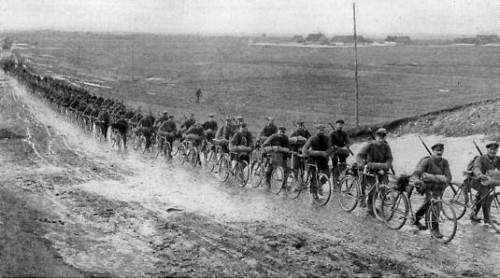
The bicycle is often considered to be an invention that has not been used for evil ends. However, bikes have been used by military planners. The biggest military use of bikes was probably in 1937, when the Japanese army made use of some 50,000 bicycle troops in their invasion of China. Bikes also helped the Japanese army to beat the British at Singapore in 1941. In the First World War bicycle units often acted as messengers.
How many bikes are there?
Approximately 105 million bicycles are made every year. This is double the number of motor cars made every year.
In total it is estimated that there are a billion bicycles in existence, with by far the most (nearly 0.5 billion) being in China.
Most Expensive Bike
The most expensive bike was auctioned for $500,000 at Sotherby’s. It was a Trek Madone designed by artist Damien Hurst. (GWR)
Lightest bike
Mirko Glöckner (Germany) constructed a full-size racing bicycle called Sub 4.0 weighing 3.89 kg (8 lb 9.2 oz).
Heaviest rideable bike

The heaviest rideable bicycle weighs 750 kg (1650 lb) It was built by Wouter van den Bosch (Netherlands) and ridden in Arnhem, Netherlands, in May 2010. That’s a tractor tyre on the front.
Cycling Calories
It is estimated that cycling at 25 mph will typically burn– 1374 calories per hour! At normal speed, average calorie consumption is around 700 per hour.
Popularity of Cycling
The popularity of cycling varies significantly between different countries.
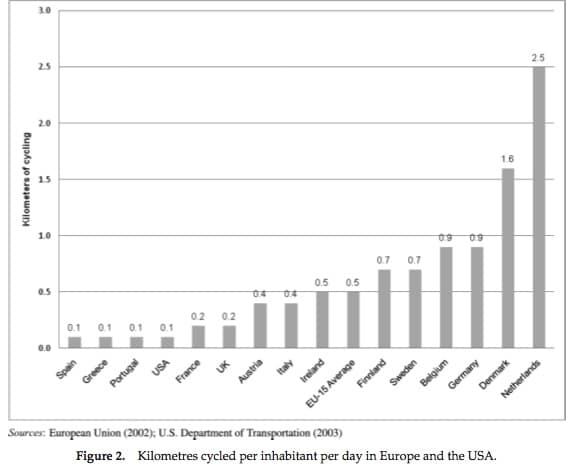
- The Netherlands has the highest rate of cycling with an average of 2.5 Km per day per person.
- In the US, this rate is 0.1 Km per person. In the UK 0.2Km (Cycling Rates by country)
Cycling Boom and Busts
In 1904, 20% of journeys in London were by bike. In 2010 this is between 1-2% of all journeys. Like many other countries, the UK experienced a dramatic fall in cycling in the post war period.
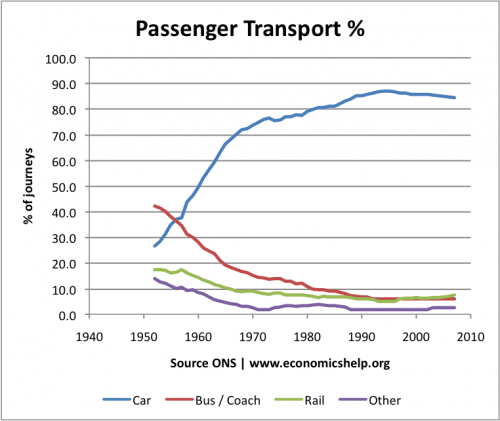
In the UK bicycle usage declined from 23.6 billion vehicle kilometres in 1949 to 4.0 billion in 1998; car use has increased from 20.3 billion vehicle kilometres to 375.9 billion in the same period. (DETR. Transport Statistics Great Britain 1999. London: The Stationery Office, 1999)
Safety of Cycling
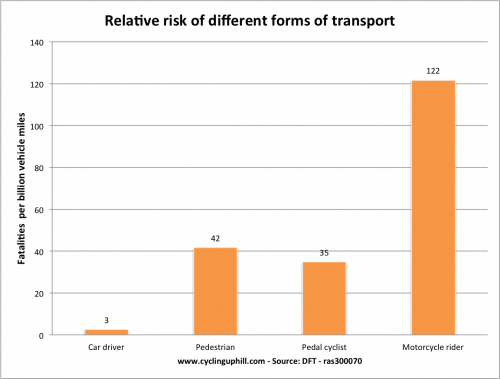
Cycling death rates varies between countries. There is usually an inverse relationship between bike use and death rates. Safety of cycling
Cycling at least 20 miles a week cuts in half your risk of heart disease compared to non-cyclists who take no exercise, according to the British Heart Foundation (BBC)
According to a survey from commuters in Copenhagen (Andersen et al, 2000).. People who don’t cycle to work have a 39% higher death rate (from any cause) than those who do.
BMX
The 1970s were an era of great innovation for cycling. In the early 1970s, a new type of bike – the bmx was developed from people imitating motor cross racing.
The 1970s also saw the development of the mountain bike, pioneered by riders in California experimenting with bikes and taking part in downhill races. The BMX and Mountain bike in particular, is largely credited with revitalising the bicycle industry in the 1980s.
Royal Cyclists
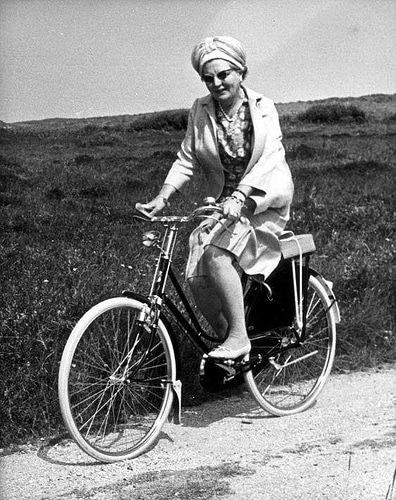
The Dutch Queen Juliana in 1967 riding a bike. However, Queen Elizabeth II of Great Britain revealed that she was “not a fan of cyclists’ (link)
Economics of Cycling
Cycling is considered the most economical form of transport. Cost per mile cycling
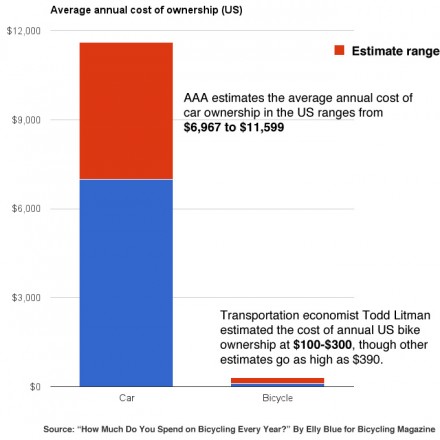
AAA estimate the annual cost of car to be upto $11,599 a year. Todd Litman estimated cost of US bike ownership at up to $300 (assuming you’re not a time trialist who spends $1000 on a new wheel) (bicycling.com)
On a bicycle you can travel up to 1037 kilometres on the energy equivalent of a single litre of petrol. (Univ of Aberdeen)
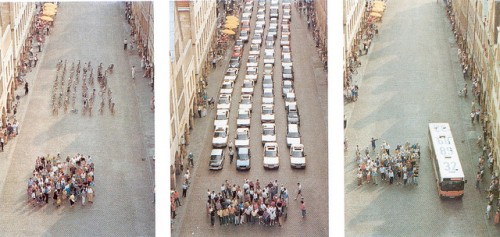
Twenty bicycles can be parked in the same space taken up by one car.
- The most efficient animal on earth in terms of weight transported over distance for energy expended is a human on a bicycle.
Cycling Records
The most prestigious cycling record is the world hour record.
- 1876 Frank Dodds rode 26.508 km (16.471 mi) on a penny-farthing.
- In 1972, Eddy Merckx set a record of 49.431 km (30.715 mi) that stood for 12 years.
- In 1996, Chris Boardman set a record of 56.375 KM on his superman position.
- For a while, the UCI set regulations making records use 1970s equipment. In 1994 Ondrej Sosenka, rode 49.700 km (30.882 mi)
- The current UCI World Hour record is 54.526 kilometres set by Bradley Wiggins, 7 June 2015.
- The women’s World Hour Record is 47.980 is Evelyn Stevens (US) 2016.
Cycling around the world
On 4 June 2012, Mike Hall completed a successful circumnavigation of the world in 91 days 18 hours. Guinness rules mean you have to travel a minimum 24,900 miles (40,073 km) for a record to be accepted.
Furthest cycling in a year
In 1939 Tommy Godwin England 75,065 miles – (120,805 km) (average of 205 miles per day) (Source: Cycling 1972) Guinness retired this record as they decided it was too extreme.
Fastest Bike
Sebastiaan Bowier reached a speed of 133.78 kilometres per hour (83.13 miles per hour) during the World Human Powered Speed Challenge in Nevada. He rode recumbent bike designed by the Delft University of Technology and the VU University Amsterdam. (link)
Cycle Popularity
- Cycle use is highest amongst men 11-16.
- Cycling is least popular amongst women aged 17-20 and 60+
- 42% of Britain’s own a bike – 2.2% say bike is main form of transport
Legal Aspects of Cycling
There is a law against ‘furious cycling’ – though rarely used.
In 1882 “Even a gentleman of a ‘most respectable address’ was fined 30 shillings for riding through London at a ‘furious’ 10 miles per hour.”
Steepest Hills
The steepest residential street in the world is claimed to be Baldwin Steet in New Zealand. On it’s steepest section, the slope of Baldwin Street is about 35%. 1 metre of height gain for every 2.86 metres travelled horizontally.
In the UK, Vale Street in Bristol is reported to be the steepest residential hill in Britain, touching 40% for a short time on the apex of the bend. It is quite short
Hardknott Pass in Lake District has a maximum gradient of 30% and climbs over 1,000 ft.
Hardest Mountain in Pro Cycling (opinion not fact)
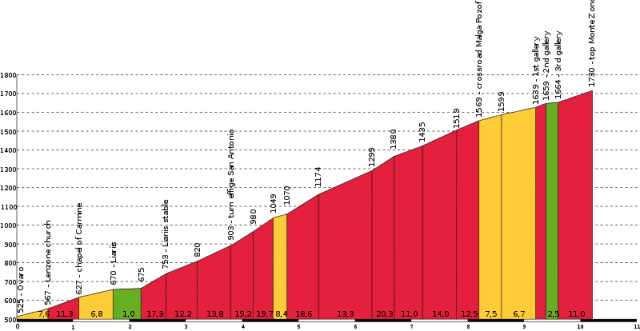
There are many mountains with a decent claim to be the hardest hill climbed by cyclists in professional cycle races. One of the best claims is Mount Zoncolan in North Italy. From Ovaro it is 10.1 kilometres (6.3 mi) long at an average of 11.9% with an elevation gain of 1,210 metres (3,970 ft) and a maximum gradient of 22%. Other mountains with a good claim, could include l’Angliru in Spain and the Col du Tormalet in France.
Random Facts
The longest “tandem” bike ever built was almost 67 feet long and could seat 35.
The slow cycling record was set by Tsugunobu Mitsuishi of Japan in 1965 when he stayed stationary for 5 hours, 25 minutes.
Related pages
Reference Books
- This Island Race” by Les Woodland
- Cycling Science at Amazon.co.uk £15.99
- Bicycle Book by Bella Bathurst
- Cyclopedia – William Fotheringham
- The Complete Book of the Tour de France

HI Tejvan,
I’d be interested how “On a bicycle you can travel up to 1037 kilometres on the energy equivalent of a single litre of petrol.” was calculated.
Here’s a quick calculation: A litre of petrol contains about 8600kcal. According to this article cycling at moderate speed will use 700kcal per hour. So cycling for 12, or so, hours would use up the energy content of a litre of petrol. Cycling 12 hours at a moderate speed won’t get you much further than 300 km. Still a pretty good return though. You can probably go further if you drop speed but 1000 km seems a bit high.
Great blog by the way!
Stephan
I must admit, I plucked that figure from the t’internet. It looked good. I suppose it depends how you cycle. There’s a huge difference between the most efficient bike and the least efficient bike
I would guess that the calculation has missed out the efficiency of your body to transfer energy to the pedals. assuming 20%. 700kcal consumption by your body probably equates to 140kcals per hours worth of work being done at the pedals
8600kcals in a L / 140kcals per hour = 61 hours
depending how fast you can go on 700kcal (on a road bike I’d assume 17mph) but on a heavy town bike it might be more like 17km/h
61 x 17mph = 1037 miles
61 x 17km/h = 1037 km (exactly the same number lol)